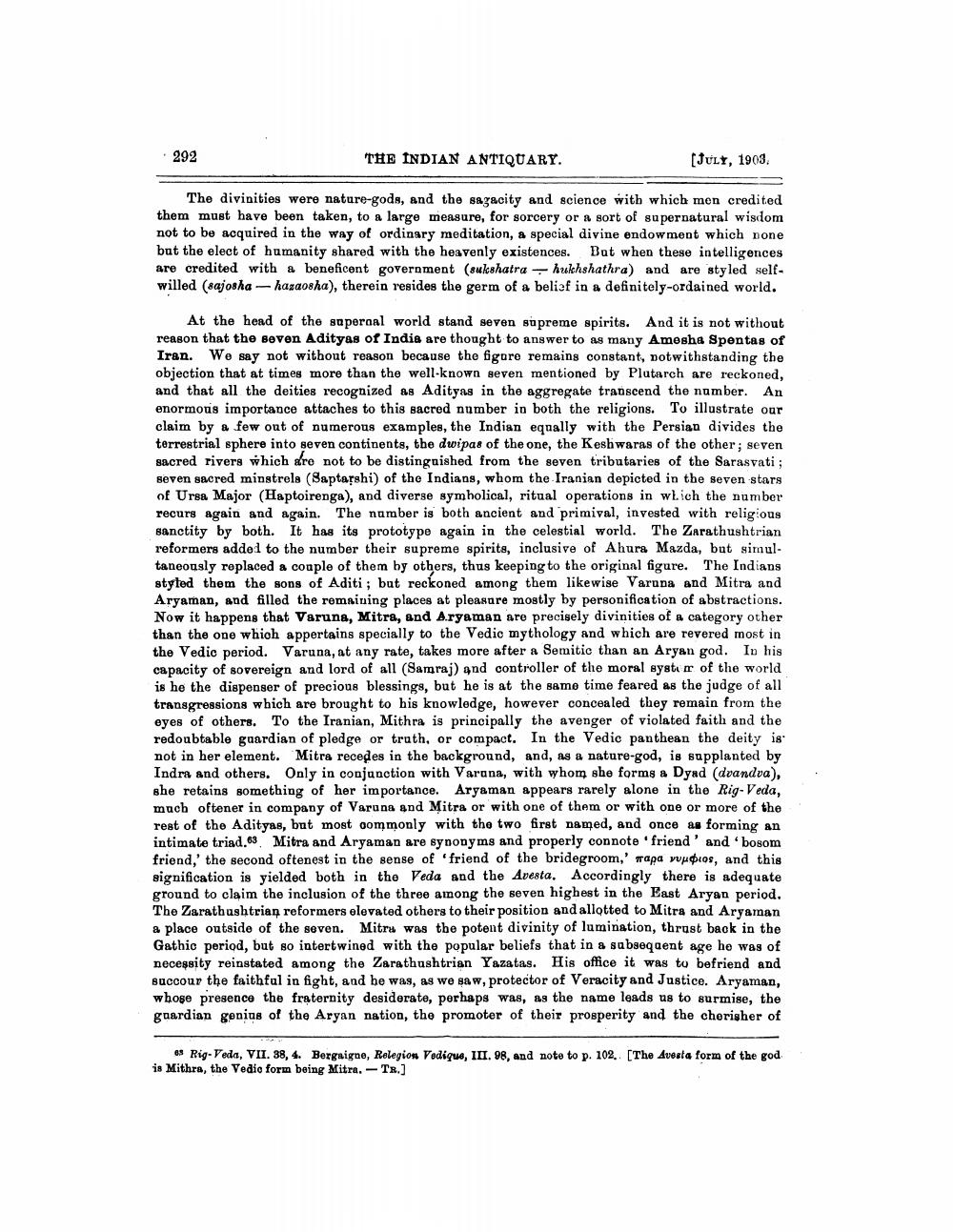________________
• 292
THE INDIAN ANTIQUARY.
[Jult, 1903
The divinities were nature-gods, and the sagacity and science with which men credited them must have been taken, to a large measure, for sorcery or a sort of supernatural wisdom not to be acquired in the way of ordinary meditation, a special divine endowment which none but the elect of humanity shared with the heavenly existences. But when these intelligences are credited with a beneficent government (sukshatra - hukhshathra) and are styled selfwilled (sajosha-haxaosha), therein resides the germ of a belief in a definitely-ordained world.
At the head of the supercal world stand seven supreme spirits. And it is not without reason that the seven Adityas of India are thought to answer to as many Amesha Spentas of Iran. We say not without reason because the figure remains constant, notwithstanding the objection that at times more than the well-known seven mentioned by Plutarch are reckoned, and that all the deities recognized as Adityas in the aggregate transcend the namber. An enormous importance attaches to this sacred number in both the religions. To illustrate our claim by a few out of numerous examples, the Indian equally with the Persian divides the terrestrial sphere into seven continents, the dwipas of the one, the Keshwaras of the other; seven sacred rivers which are not to be distingaished from the seven tributaries of the Sarasvati; seven sacred minstrels (Saptarshi) of the Indians, whom the Iranian depicted in the seven stars of Ursa Major (Haptoirenga), and diverse symholical, ritual operations in which the number recurs again and again. The number is both ancient and primival, invested with religious sanctity by both. It has its prototype again in the celestial world. The Zarathushtrian reformers added to the number their supreme spirits, inclusive of Ahura Mazda, but simul taneously replaced a couple of them by others, thus keeping to the original figure. The Indians styled them the sons of Aditi; but reckoned among them likewise Varuna and Mitra and Aryaman, and filled the remaining places at pleasure mostly by personification of abstractions. Now it happens that Varuna, Mitra, and A.ryaman are precisely divinities of a category other than the one which appertains specially to the Vedic mythology and which are revered most in the Vedio period. Varuna, at any rate, takes more after a Semitic than an Aryan god. In his capacity of sovereign and lord of all (Samraj) and controller of the moral system of the world is he the dispenser of precious blessings, but he is at the same time feared as the judge of all transgressions which are brought to his knowledge, however concealed they remain from the eyes of others. To the Iranian, Mithra is principally the avenger of violated faith and the redoubtable guardian of pledge or truth, or compact. In the Vedic panthean the deity is not in her element. Mitra recedes in the background, and, as a nature-god, is supplanted by Indra and others. Only in conjunction with Varana, with whom she forms a Dyad (doandva), she retains something of her importance. Aryaman appears rarely alone in the Rig Veda, much oftener in company of Varuna and Mitra or with one of them or with one or more of the rest of the Adityas, but most commonly with the two first named, and once as forming an intimate triad.63 Mitra and Aryaman are synonyms and properly connote 'friend' and 'bosom friend,' the second oftenest in the sense of 'friend of the bridegroom,' mapa wudros, and this signification is yielded both in the Veda and the Avesta. Accordingly there is adequate ground to claim the inclusion of the three ainong the seven highest in the East Aryan period. The Zarathushtrian reformers elevated others to their position and allotted to Mitra and Aryaman a place outside of the seven. Mitra was the potent divinity of lumination, thrust back in the Gathic period, but so intertwined with the popular beliefs that in a subsequent age he was of necessity reinstated among the Zarathushtrian Yazatas. His office it was to befriend and succour the faithful in fight, and he was, as we saw, protector of Veracity and Justice. Aryaman, whose presence the fraternity desiderate, perhaps was, as the name leads us to surmise, the guardian genius of the Aryan nation, the promoter of their prosperity and the cherisher of
os Rig Veda, VII. 38, 4. Berguigno, Rolegion Vedique, III. 98, and noto to p. 102. [The Avesta form of the god is Mithra, the Vedio form being Mitra. - TR.]




